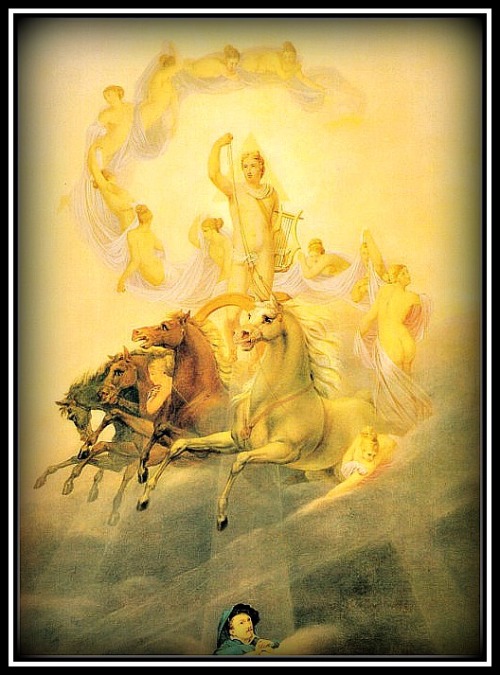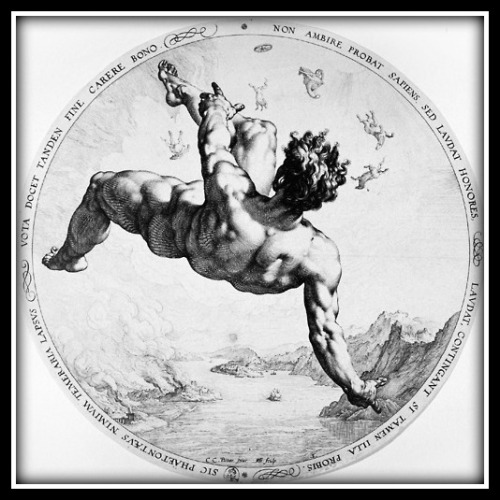►Greek Mythology: “The Charites” (“The Three Graces”):

Fresco from Pompeii, House of Titus Dentatus Panthera, ca 65 -79 AD; Museo Archeologico Nazionale di Napoli – Three Graces
_________________________________________________________________________________________________
The Charites (Three Graces) were reputed to be the essence of beauty, charm, and grace and were associated with the Nine Muses, who presided and inspired arts and sciences.
The Charites were three goddesses, who were sisters between them: Aglaia (Αγλαια Brightness), Euphrosyne (Ευφροσυνη Joyfulness), and Thalia (Θαλια Bloom).
The character and nature of the Charites are sufficiently expressed by the names they bear: they were conceived as the goddesses who gave festive joy and enhanced the enjoyments of life
Pindar, Olympian Ode 14: “Kharites (Charites, Graces) three . . . Euphrosyne, lover of song, and Aglaia (Aglaea) revered, daughters of Zeus the all-highest . . . with Thalia, darling of harmony.”
They are said to be daughters of Zeus and Hera (or Eurynome, daughter of Oceanus) or of Helios and Aegle, a daughter of Zeus.
The Charites were also joined in the banquets, celebrations by the Horae who were the keepers of the gates to Mount Olympus.
Aglaia was the charis goddess of beauty, adornment, splendor and glory. Aglaia was a the wife of the god Hephaistos and like her she represented the creation of objects of beauty and artistic adornment.
Homer, Iliad 18. 382: “Kharis (Charis) of the shining veil . . . the lovely goddess the renowned strong-armed one [Hephaistos] had married.”
Euphrosyne was the charis goddess of good cheer, joy, mirth and merriment
Thalia was the charis goddess of festive celebrations and rich and luxurious banquets.
Frequently the Graces were taken as goddesses of charm or beauty in general and hence were associated with Aphrodite, the goddess of love; Peitho, her attendant; and Hermes, a fertility and messenger god.
As attendants of Aphrodite they were goddesses of personal beauty and the adornments which enhanced this: makeup, oils, perfumes, fine clothing and jewellery.
Homeric Hymn 5 to Aphrodite: “She [Aphrodite] went to Kypros (Cyprus), to Paphos, wher her precinct is and fragrant altar, and passed into her sweet-smelling temple. There she went in and put to the glittering doors, and there the Kharites (Charites, Graces) bathed her with heavenly oil such as blooms upon the bodies of the eternal gods–oil divinely sweet, which she had by her, filled with fragrance.”
Sometimes they were depicted as companions of Apollo and the Muses:
Hesiod, Theogony 53: “There [on Olympos] are their [the Muses’] bright dancing-places and beautiful homes, and beside them the Kharites (Charites, Graces) . . . live in delight.”
The Charitesia were annual competitions and games in honor of the Graces. There were athletic competitions, literary, musical and dramatic contests (which took place in the theater). The Charitesia festival was held at Orchomenos near the modern town of Kalpaki.
______________________________________________________________________________________________
________________________________________________________________________________________________
►Slideshare: “The Charites” (“The Three Graces”):
__________________________________________________________________________________________________
___________________________________________________________________________________________________
►Links post
http://www.theoi.com/Ouranios/Kharites.html
http://www.talesbeyondbelief.com/nymphs/three-graces.htm
http://www.britannica.com/EBchecked/topic/240434/Grace
http://www.mythography.com/myth/welcome-to-mythography/greek-gods/spirits-1/graces/
_____________________________________________________________________________________________
______________________________________________________________________________________________
►Last but not Least: One Lovely Blog Award (x2):
_________________________________________________________________________________________________
I want to thank Shehanne Moore for nominating me for a Lovely Blog Award. Shehanne is an scottish blogger and author of “Smexy Historical romance”, “the Unraveling of Lady Fury” and “Loving Lady Lazuli”, among others. Meet Shehanne at her blog.
I also want to thank D.G. Kaye for nominating me for this same Award. Please make sure to check out her author blog. She is a canadian author and has published “Conflicted Hearts”, “Meno-What?, a Memoir” and “Words We carry”. You can also take a peek on my latest post in which I featured her new book “Words we Carry”.
►Here are the Award Ruless:
1) The nominee shall display the respective logo on her/his blog and link to the blogger that has nominated her/him.
2) The nominee shall nominate ten (10) bloggers she/he admires, by linking to their blogs and informing them about the nomination.
In this occasion, I will nominate -in no particular order- new followers and/or great bloggers I have recently met or that I haven’t nominated yet.
_____________________________________________________________________________________________________
►So without further ado, these are my nominees for the Lovely Blog Award:
1. Medgekorne 2. Kely has a Blog 3. Sacred Touches 4. A Universal Life 5. Dennis’ Diary of Destruction 6. Strings of Soulfulness 7. Meditation Travelogue 8. Ombreflessuose 9. Tavolozza di Vita 10. Dotedon.
__________________________________________________________________________________________________
Thanks D.G Kaye and Shehanne Moore for this Award.
By the way, I love the way Shehanne Moore featured my Lovely Blog Award nomination at her blog.
Thank you for that, Shehanne and Hamstahs!. Aquileana 😀

Source: “One lovely Blog Award”. At: http://shehannemoore.wordpress.com/2014/11/07/one-lovely-blog-award/

Source Hamsters Images: Source: http://shehannemoore.wordpress.com/2014/11/07/one-lovely-blog-award/. The third one is mine (moi).
__________________________________________________________________________________________________
__________________________________________________________________________________________________


























































